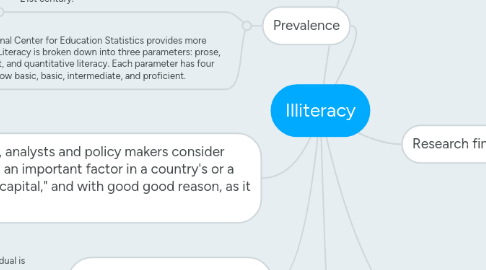
1. Relationship between poverty and crime
1.1. In developed countries, the level of functional literacy of an individual is proportional to the level of income and the risk of committing the crime. For example, according to the National Center for Education Statistics in the United States 5 Over 60% of adults in the US prison system
1.1.1. They can not read do below the fourth grade level. 85% of Americans under age prisoners are functionally illiterate. 43% of adults at the lowest level of literacy living below the poverty line, compared with 4% of those with the highest levels of literacy. according begintoread.com:6 Two-thirds of students who can not read fluently in fourth grade will end up in jail or need help from public institutions.
1.1.1.1. Three out of four people who receive food stamps read at the two lowest levels of literacy.
2. On a global level, analysts and policy makers consider illiteracy rates as an important factor in a country's or a region's "human capital," and with good good reason, as it turns out.
2.1. Based on numerous studies into this area, they conclude that literate people are easier and less expensive to train and have broader job opportunities and access to higher education.
2.1.1. In Kerala, India, for example, female and child mortality rates declined dramatically in the 1960s, after girls who had been schooled to literacy in the education reforms after 1948 began to raise families.
2.1.1.1. There are recent findings, however, that raise questions on correlations such as the one listed above, arguing that these may have more to do with the effects of schooling rather than literacy in general.
3. Prevalence
3.1. In the United States, according to Business magazine, an estimated 15 million functionally illiterate adults held jobs at the beginning of the 21st century.
3.1.1. The American Council of Life Insurers reported that 75% of the Fortune 500 companies provide some level of remedial training for their workers. All over the U.S.A. 30 million (14% of adults) are unable to perform simple and everyday literacy activities.[5]
3.2. The National Center for Education Statistics provides more detail.[6] Literacy is broken down into three parameters: prose, document, and quantitative literacy. Each parameter has four levels: below basic, basic, intermediate, and proficient.
3.2.1. For prose literacy, for example, a below basic level of literacy means that a person can look at a short piece of text to get a small piece of uncomplicated information, while a person who is below basic in quantitative literacy would be able to do simple addition. In the US, 14% of the adult population is at the "below basic" level for prose literacy; 12% are at the "below basic" level for document literacy; and 22% are at that level for quantitative literacy
3.2.1.1. Only 13% of the population is proficient in these three areas—able to compare viewpoints in two editorials; interpret a table about blood pressure, age, and physical activity; or compute and compare the cost per ounce of food items.
4. Low access to basic education
4.1. Some countries may be poor reading comprehension despite his illiteracy rate is small (functional illiteracy), because reading is not only know but understand letters written messages.
5. What is...
5.1. According to the United Nations an illiterate person is one who can not read or write a short and simple message related to their daily lives
5.2. Illiteracy can have many definitions. For some it is simply the inability to read and write which is usually due to lack of education of the same capabilities.
5.2.1. Avala this definition the fact that in countries with compulsory schooling illiteracy is a minority.
